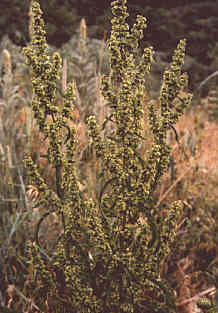
Plant Description
Caution & Interaction

Latin (botanical) name:
Rumex crispus
Common names: Yellow Dock, Curled Dock, Narrow Dock, Narrow-Leafed Dock, Garden Patience, Sour Dock, Rumex
Plant Description: The main identifying characteristics of Yellow Dock are the narrowness of the leaves. They are very curly at their edges, and a deep yellow. A native British perennial herb, it grows freely on roadsides, in ditches and wastelands. Yellow Dock's spindle-shaped taproot, which grows 8-12 inches long, has a reddish-brown somewhat thick bark and is yellowish inside. From it arises a smooth, thin stem about 1-3 feet high and branched. It has pointed, light green leaves with wavy margins, and from June to July produces pale green drooping flowers in panicled racemes. The fruit of Yellow Dock is a pointed, heart-shaped nut.
Medicinal Properties &Uses: The main constituents of Yellow Dock are hydroanthraquinone glycosides, tannins, bitter principles, resin, and iron. Yellow Dock has anti-cancer properties and has been used as an alterative to debility caused by cancer and necrosis. The root has laxative and mildly tonic action and is used in bilious complaints, rheumatism, and diptheria. Yellow Dock is most often used in the treatment of blood diseases from jaundice to scurvy, to chronic skin diseases. Because of their astringent action, the seeds from the fruit of Yellow Dock have proven to be effective against dysentery. The anthraquinones have a cathartic action on the bowel, acting in a gentle manner. Yellow Dock is also an effective treatment for anemia, as it has a high iron content.
Dosage: 30-60 drops in water or juice, 2-3 times daily or as needed. Shake well before using.
Cautions & Interactions: Keep out of reach of children.
Efficacy Studies & Other Clinical Data:
Disclaimer (U.S. Only): These statements have not been evaluated by the FDA. These products are not intended to diagnose, cure, treat, or prevent any disease.
Common names: Yellow Dock, Curled Dock, Narrow Dock, Narrow-Leafed Dock, Garden Patience, Sour Dock, Rumex
Plant Description: The main identifying characteristics of Yellow Dock are the narrowness of the leaves. They are very curly at their edges, and a deep yellow. A native British perennial herb, it grows freely on roadsides, in ditches and wastelands. Yellow Dock's spindle-shaped taproot, which grows 8-12 inches long, has a reddish-brown somewhat thick bark and is yellowish inside. From it arises a smooth, thin stem about 1-3 feet high and branched. It has pointed, light green leaves with wavy margins, and from June to July produces pale green drooping flowers in panicled racemes. The fruit of Yellow Dock is a pointed, heart-shaped nut.
Medicinal Properties &Uses: The main constituents of Yellow Dock are hydroanthraquinone glycosides, tannins, bitter principles, resin, and iron. Yellow Dock has anti-cancer properties and has been used as an alterative to debility caused by cancer and necrosis. The root has laxative and mildly tonic action and is used in bilious complaints, rheumatism, and diptheria. Yellow Dock is most often used in the treatment of blood diseases from jaundice to scurvy, to chronic skin diseases. Because of their astringent action, the seeds from the fruit of Yellow Dock have proven to be effective against dysentery. The anthraquinones have a cathartic action on the bowel, acting in a gentle manner. Yellow Dock is also an effective treatment for anemia, as it has a high iron content.
Dosage: 30-60 drops in water or juice, 2-3 times daily or as needed. Shake well before using.
Cautions & Interactions: Keep out of reach of children.
Efficacy Studies & Other Clinical Data:
-
Supplement Watch - Clinical Studies Yellow Dock
-
Northwestern Memorial Hospital - Health Library, Complementary and Alternative
Medicine - Yellow Dock
Disclaimer (U.S. Only): These statements have not been evaluated by the FDA. These products are not intended to diagnose, cure, treat, or prevent any disease.